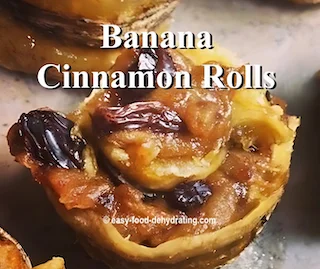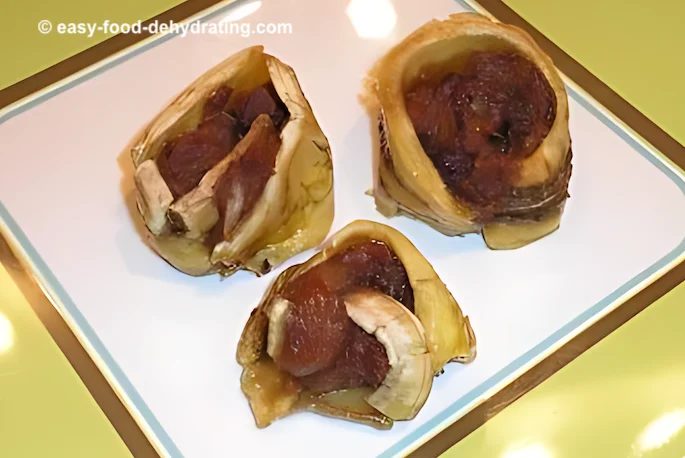What We Mean by “Dehydrate”
Here at Easy Food Dehydrating, “dehydrate” always means using an electric food dehydrator — the easy, reliable way to dry food at home.
- Home
- Dehydrating Fruits: Step-by-Step Guides by Type
- How to Dehydrate Bananas
How to Dehydrate Bananas for Easy, Healthy Snacking

If you’ve got bananas ripening faster than you can eat them, dehydrating is your secret weapon. In just a few hours, you can turn fresh bananas into chewy or crispy chips—perfect for healthy snacking, trail mixes, or adding to baked goods.
✅ Quick Answer: How do you dehydrate bananas?
Slice ripe bananas, pre-treat to prevent browning, then dry at 135°F until chewy or crisp. Store in airtight jars for up to a year.
This step-by-step guide shows you how to slice, pre-treat, and dry bananas so they keep their flavor and last for months.
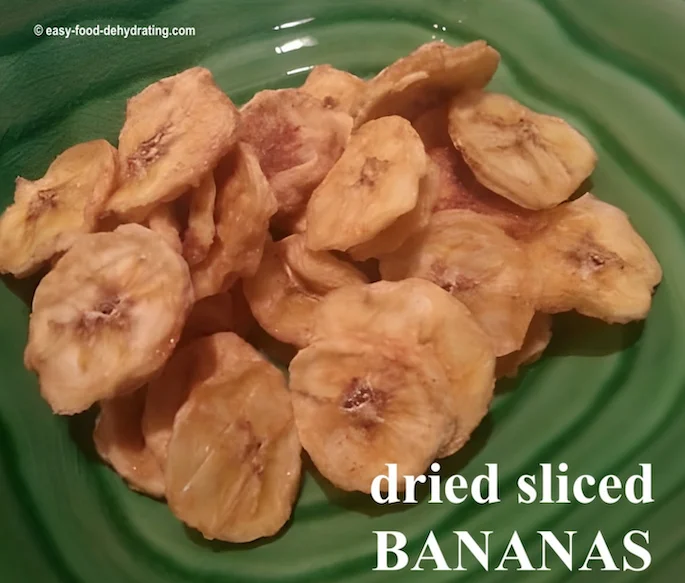 Dehydrated Banana Chips
Dehydrated Banana ChipsNot only are these dehydrated bananas great for backpacking adventures, but they can also be re-hydrated to make a tasty banana pudding.
Dehydrating them with a dehydrator is an excellent way to use up those overripe bananas that seem to ripen so quickly. The longer you let your bananas "go," the sweeter and softer they become, making them ideal for dehydration.
However, if your bananas are "too far gone," consider using them in smoothies instead—the riper, the better!
It's Time to Make Your Own Banana Chips!
just for fun...
Bananas Nutrition Info.
VITAMINS: Vitamin B6, and a lesser amount of Vitamin C. Also in lesser amounts: Vitamin B3, Vitamin B9 (folate), and Vitamin E.
MINERALS: Potassium, Calcium, Phosphorus, and Manganese. There are trace amounts of Iron, Zinc, and Copper, too.
Bananas contain Omega-3 and Omega-6 fatty acids too.
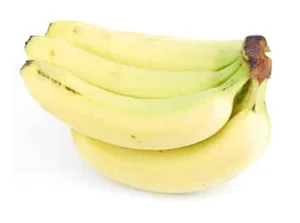
Bananas are a good source of dietary fiber. They're also low in calories and fat.
Eating bananas can help you regulate your blood sugar levels. This is especially important for people with diabetes.
FRESH bananas can also help you stay hydrated. This is because they're more than 70% water by weight.
Please take time to read the interesting FAQ section near top of the page that addresses many of the statements I just wrote, thanks!
Step-by-Step: How to Dehydrate Bananas the Right Way
TIP: Chill bananas a short while first for easier slicing—less mushiness.
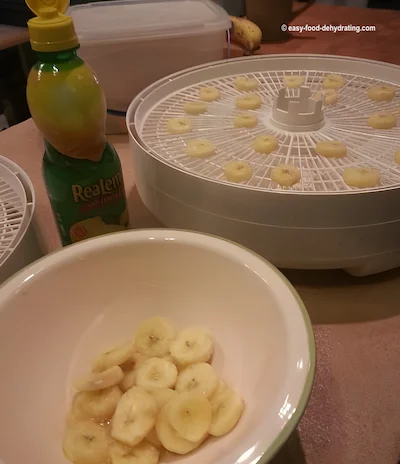
- Prepare the bananas by unzipping them and slicing them evenly. Not too thick and not too thin. Use a knife and a chopping board, pass on using a mandoline - bananas are too squishy (even chilled) for a mandoline and are easy to chop with a knife!
- Grab a bowl and generously spray the banana slices with lemon juice, tossing gently to make sure they are evenly coated. TIP: Use a pump top from a new unused spray bottle; pick one that fits your lemon juice bottle, and look for one that has a long enough plastic tube that will reach the bottom of your lemon juice bottle.
- Arrange the sliced bananas on your dehydrator trays, making sure they don't overlap.
- Turn on your dehydrator and set the temperature between 125°F and 135°F (or per your food dehydrator's instructions).
💡 Tip: Outside the U.S.? Most dehydrating temps here are listed in Fahrenheit - use our quick converter to see the Celsius equivalent for your machine.
- Dried bananas will feel leathery when fully dried.
- Drying time: between 6-12 hours.
- Please remember to rotate your trays, for even drying.
Don't forget, you can slice your bananas lengthwise too—so you can wrap a slice around dates and other fruits (see this recipe Banana Cinnamon Rolls).
Best Banana Types for Dehydrating (And One You Should Skip!)
When learning how to dehydrate bananas, you'll find there are many different types that can be used. However, some varieties are better than others.
For example, Cavendish bananas are the most popular type of banana in the world. They're also the type of banana that is typically used in commercial banana chips.
Other good banana options include plantains, Lady Finger bananas, and Red Dacca bananas. Experiment and see what type of banana you like best!
Want to Grow Bananas? Here’s What You Need to Know
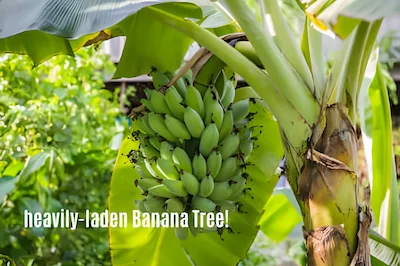 At Casa Ybel, Sanibel Island, Florida
At Casa Ybel, Sanibel Island, FloridaBananas are fairly easy to grow, but they do require some special care. For example, they need to be planted in an area that receives full sun. They also need to be watered regularly.
If you live in an area with a tropical climate, you may be able to grow bananas outdoors all year round.
However, if you live in a cooler climate, you'll need to bring the plants indoors during the winter months, or at the very least, cover them up.
BONUS RECIPE: Make Our Delicious Banana Cinnamon Rolls
NOTE: Check out this fantastic recipe for healthy Banana Cinnamon Rolls and they're pretty much "fat-free" if you're watching your fat intake.
Bananas are great anyway you slice 'em, but dehydrated bananas are fantastic in granola, banana bread, pudding, cookies... and baby food!
Bananas sliced lengthwise are perfect for our Banana Cinnamon Rolls.
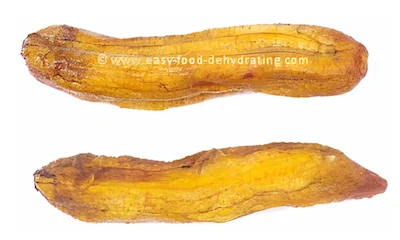
Your Top Banana Dehydrating Questions—Answered!
How to dehydrate bananas in air fryer?
How to dehydrate bananas in air fryer?
Peel, slice ¼–½" thick, lay in single layer, lowest temp (120–140°F), 5–8 hrs, flipping a few times until leathery. Store airtight.
Are dried bananas good for dogs?
Are dried bananas good for dogs?
Yes—in moderation. A few chips 2–3 times a week is fine. Break into small pieces, and check with your vet first.
Are dried bananas high in potassium?
Are dried bananas high in potassium?
Yes—great for muscles and nerves, but watch carbs if limiting sugar.
Are dehydrated bananas healthy?
Are dehydrated bananas healthy?
Yes—rich in potassium and fiber. Just enjoy in moderation.
Are dried bananas good for diabetics?
Are dried bananas good for diabetics?
Possible in moderation—keep to 1–2 tbsp per serving, choose unsweetened, and pair with protein/fat. Monitor your blood sugar.
Do I need to use lemon juice when dehydrating bananas?
Do I need to use lemon juice when dehydrating bananas?
Yes—prevents browning and adds flavor. Use fresh or 100% bottled juice.
Once you master dehydrating bananas, you’ll be hooked on how easy and satisfying food dehydration can be.
Why stop at bananas? My free “5 Easy Dried Food Recipes” PDF gives you quick, flavor-packed meals you can make from pantry-friendly dried ingredients. They’re tested, tasty, and yours—just click below to grab them!
Get 5 Dried Food Recipes You'll Actually Love
Here's where you can get your copy of our all new
5 Dried Food Recipes (That Actually Taste Great)
They're my all-time favorite easy dried food meals!
Get it here right now.
For Free!
Before You Go...
If you enjoyed this page, tap the ❤️ in the lower right-hand corner.
It saves this page to your Grow bookmarks so you can find it again later.
You’ll also see quick share buttons to copy the link, post to Facebook,
or save it straight to Pinterest.
